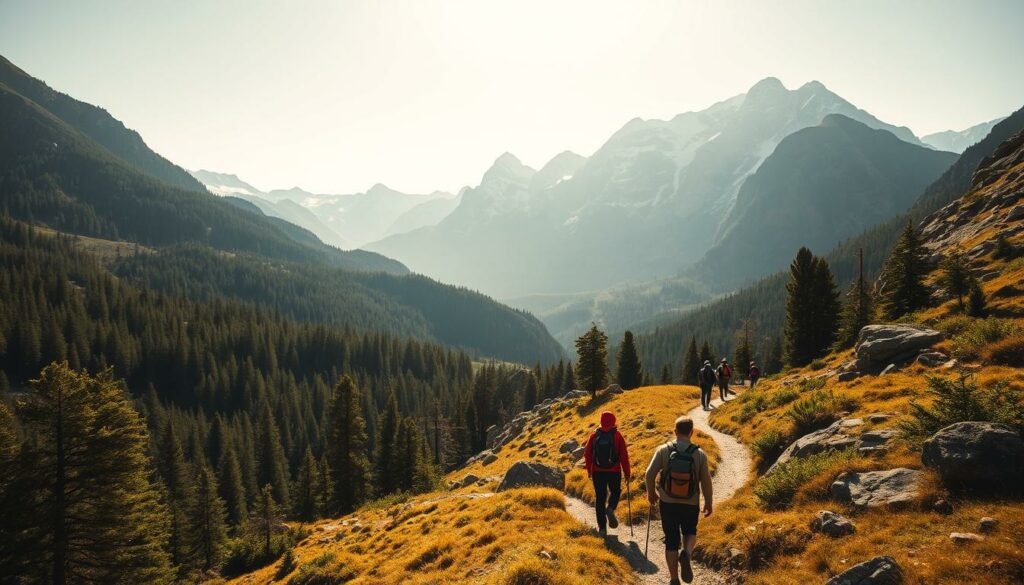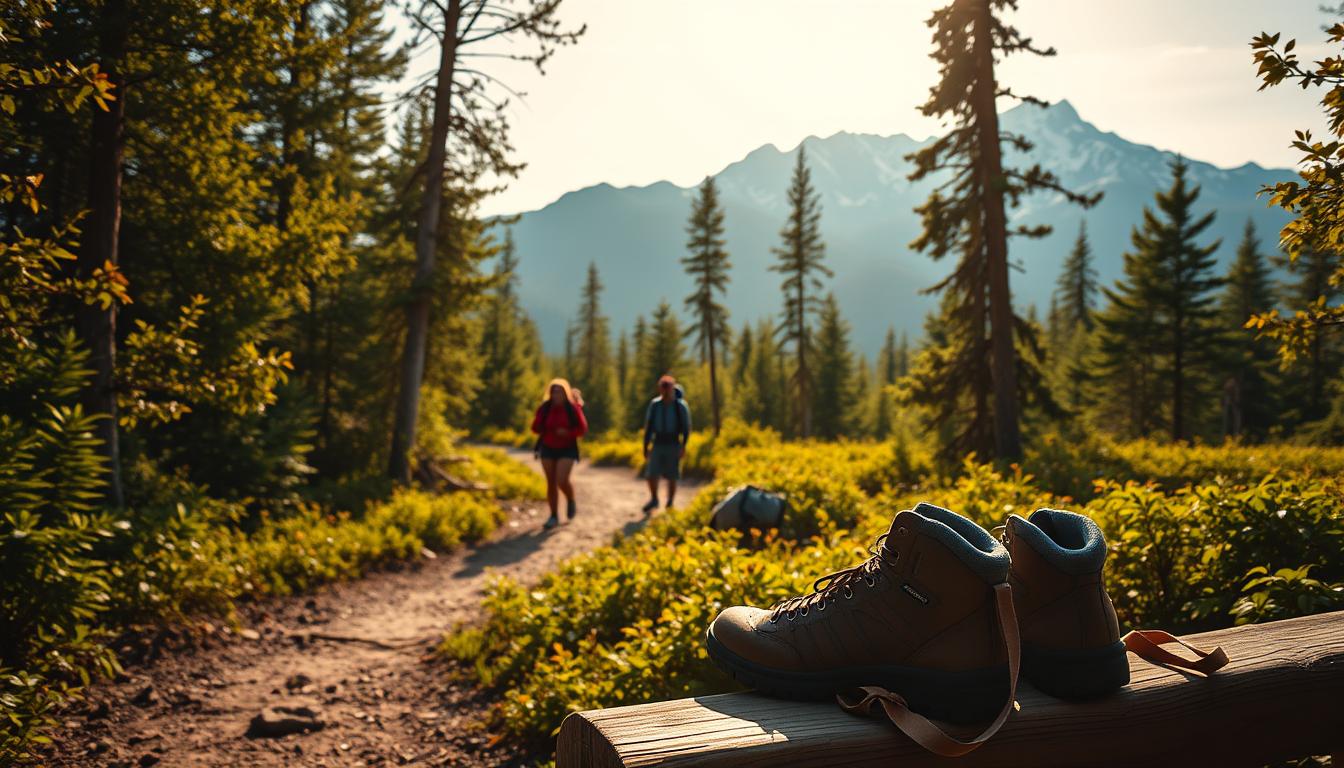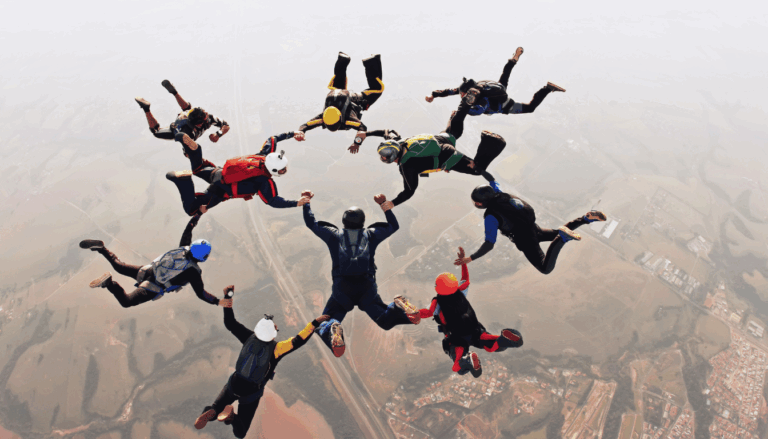Beginner’s Guide to Multi-Day Hiking Trips
Starting a multi-day hiking adventure is exciting. It lets you step away from daily life and bond with nature. Whether you want a quick weekend trip or a longer, tougher journey, planning is crucial for a great trip.
For beginners, knowing the basics is key. This guide will show you how to plan, prepare, and enjoy your first long hiking trip. We’ll cover everything from picking the right trail to packing the essential gear.
Key Takeaways
- Plan your route and itinerary carefully
- Pack essential gear, including shelter, food, and first aid supplies
- Prepare physically and mentally for the challenge ahead
- Learn basic outdoor skills, such as navigation and camp setup
- Consider your safety and the environment when hiking
Understanding Multi-Day Hiking Trips
Multi-day hiking trips are exciting because they push your limits and offer stunning views. They are different from day hikes because they need more planning and physical strength.

What Sets Multi-Day Hiking Apart from Day Hikes
Multi-day hikes are unique because you stay overnight in the wild. You must carry all your gear, like shelter and food. This type of hike requires strong physical and mental strength.
Also, multi-day hikes have varied terrain and weather. Being flexible and adaptable is key.
Benefits of Extended Time on the Trail
Staying on the trail for days has many benefits. It lets you connect deeply with nature. You can also pace yourself and enjoy the scenery.
Moreover, multi-day hikes are a chance to challenge yourself and feel a great sense of achievement.
Common Challenges for Beginners
Beginners face several challenges on multi-day hikes. These include physical fatigue, unpredictable weather, and navigation difficulties. To tackle these, plan well, pack the right gear, and know the trail conditions.
By understanding these challenges, you can prepare for a great hiking adventure.
Assessing Your Fitness Level and Experience
Before you start a multi-day hike, check your fitness and experience. This step helps you get ready for what’s coming and keeps you safe from injuries.
Realistic Self-Evaluation for Hiking Trips
To get ready for a hike, truly evaluate your fitness. Think about your past hikes, including how far you’ve gone and the terrain. Be honest about what you can do; too much can cause tiredness or harm.
As outdoor fans say, “Knowing your limits is as important as knowing your trail.” – A seasoned hiker. This way, you plan a trip that’s fun and safe.
Building Stamina Before Your Trip
Getting in shape is key for long hikes. Start with cardio like fast walking, jogging, or biking. Work on getting stronger by doing more intense and longer workouts.
- Start with short hikes and then go longer.
- Add strength training to boost your hiking skills.
- Practice hiking with a heavy backpack to get used to the real trip.
Training Recommendations for Beginners
Beginners should start training 2-3 months before their trip. Stay consistent; aim for 3-4 workouts a week. Mix cardio, strength, and flexibility exercises.
“The journey of a thousand miles begins with a single step.” –

How to Plan a Hiking Trip: The Fundamentals
Planning a hiking trip well is key to a great experience. A good plan means a safe and fun journey. You’ll get to enjoy nature’s beauty without stress.
Selecting the Right Season and Duration
Picking the right season for your hike is important. Weather varies by region. For example, Utah hiking trips are best in spring and fall when it’s mild.
Think about how long you want to hike. Beginners should start with short trips. As you get more experienced, you can hike longer.
Researching Trail Options and Difficulty Levels
Researching trails is a must. Find trails that fit your skill and interests. Use websites, guides, and forums for info on trails.
Colorado hiking trips have trails for all levels. Knowing the trail’s difficulty helps you prepare better.
| Trail Name | Location | Difficulty Level | Distance |
|---|---|---|---|
| Maroon Bells Circuit | Colorado | Moderate to Difficult | 27 miles |
| Zion Narrows | Utah | Moderate | 23 miles |
| Grand Canyon Rim-to-Rim | Arizona | Difficult | 23 miles |
Creating a Flexible Itinerary
A flexible plan is vital for a good hike. Having a plan is good, but be ready to change it. Weather, trail closures, or how you feel can change things.
Make sure your plan includes rest days or backup plans. Being flexible reduces stress and makes your hike better.
Understanding Permits and Reservations
Many trails need permits or reservations. Knowing the rules and getting permits early is important. It helps avoid last-minute problems.
Check the permit rules for your trail early. Some trails have limited spots, so apply early to get yours.
Essential Gear for Multi-Day Hiking Trips
For a great multi-day hike, the right gear is key. This includes backpacks, clothing, and more. The right stuff can make your trip more comfortable and safe.
Backpack Selection and Fitting
Finding the perfect backpack is important. It should fit your body and have adjustable straps. A 60-80 liter pack is good for longer trips.
Key Features to Consider:
- Durable, water-resistant material
- Multiple compartments for organization
- Ventilation system for back comfort
- Hydration bladder compatibility
Shelter Options: Tents, Tarps, and Hammocks
Choosing the right shelter is crucial. Tents keep you dry, tarps are light, and hammocks are comfy in the woods.
| Shelter Type | Weight | Space | Weather Protection |
|---|---|---|---|
| Tent | 3-5 lbs | 2-4 person capacity | High |
| Tarp | 1-3 lbs | Variable | Moderate |
| Hammock | 1-2 lbs | Single person | Low to Moderate |
Sleep Systems for Comfort and Safety
Good sleep is vital for recovery. Your sleep setup should include a bag, pad, and ground cloth.
Choose your sleeping bag based on the season and cold. A pad adds comfort, and a ground cloth keeps your tent dry.
Clothing Layers and Footwear Considerations
Wearing layers helps you adjust to the weather. Pick moisture-wicking base layers, insulating mid-layers, and waterproof outer layers. Your shoes should be sturdy, waterproof, and comfortable.
- Choose hiking boots or trail running shoes based on your terrain
- Consider gaiters and trekking poles for challenging conditions
- Break in your footwear before your trip to avoid blisters
Food and Water Planning for the Trail
To stay fueled and hydrated on your multi-day hike, plan your food and water carefully. Good nutrition and hydration keep your energy up and health on track.
Calculating Daily Caloric Needs
First, figure out how many calories you need each day. This depends on your age, weight, gender, and how hard you’re hiking. Most hikers need 2,000 to 4,000 calories daily, with tougher hikes needing more.
Use a hiking calorie calculator or talk to a nutrition expert to get an idea. This helps you pick meals that are both healthy and give you the energy you need.
Meal Planning and Preparation
After knowing your calorie needs, plan your meals. Choose foods that are light, high in calories, and easy to make. Dehydrated meals, nuts, dried fruits, and energy bars are good options.
Also, think about how you’ll prepare your meals. Bring a portable stove or camping gear to boil water safely. Remember to pack enough stove fuel and a way to purify water, like filters or tablets.
Water Sources and Purification Methods
Finding clean drinking water is key on long hikes. Look for streams, rivers, and lakes along your path. But always purify the water first to stay healthy.
There are many ways to purify water, like filters, tablets, or boiling. Pick what works best for you and make sure you have the right gear.
Food Storage and Wildlife Safety
Keeping your food safe is important to avoid attracting animals. Use airtight containers or bear-resistant bags to store your food. In bear country, consider a portable bear canister.
Hang your food and trash bags high and far from your camp to keep animals away. Follow local rules and best practices to protect the environment.
Navigation and Safety Essentials
Before you start hiking, make sure you have the right tools and knowledge. This includes safe navigation and emergency preparedness for your hiking trip.
Map and Compass Skills
Learning to use a map and compass is key for hikers. Even with GPS, knowing these skills can save your life if your tech fails. Start by getting to know the symbols and scales on maps. Practice using a compass to find directions.
Mastering map and compass skills takes practice. Try to use them to find your way on your next weekend hiking trips near me.
GPS and Digital Navigation Tools
GPS devices and apps can also help you navigate. They give precise location info and are great in bad weather. Make sure you know how to set waypoints and use the compass on your device.
Don’t forget extra batteries and a charger for your GPS. Learn how to use it before your hiking trip.
Emergency Communication Devices
Emergency devices are vital for calling for help. A satellite phone or PLB can save lives in remote areas. Think about getting one for your next adventure.
Choose a device with good battery life and durability. Make sure to register it and know how to send a distress signal.
First Aid Kit Essentials
A good first aid kit is essential for any hiking trip. It should have bandages, antiseptic wipes, pain relievers, and any needed medications. Add items like snake bite kits or blister care for your specific hike.
Check your first aid kit often to make sure everything is good to go. Knowing how to use these items is just as important. Take time to learn basic first aid before your next trip.
Best Hiking Trips for Beginners in the USA
The USA has many trails perfect for beginners. You can find quick weekend trips or longer hikes. There’s something for everyone.
Weekend Hiking Trips Near Major Cities
You don’t have to go far to enjoy nature. Many cities have trails close by for a weekend hike. For example, Red Rock Canyon near Las Vegas has beautiful views and easy trails. The White Mountains near Boston also have trails for all levels.
Utah Hiking Trip Destinations for Novices
Utah is known for its beauty, with many beginner trails. The Zion Narrows is a good place to start, with its easy hike along the Virgin River. Bryce Canyon is also great, with its unique hoodoos and gentle paths.
Colorado Hiking Trips with Stunning Views
Colorado is a dream for hikers, especially the Rocky Mountain National Park. Trails like Alberta Falls offer amazing views and are easy. For a relaxed hike, try the Maroon Bells scenic trail.
Accessible Grand Canyon Hiking Trips
The Grand Canyon is a famous hiking spot, with trails for all. The Rim Trail is perfect for beginners, with stunning views. For a deeper experience, try the Bright Angel Trail, which is well-kept and has rest stops.
International Hiking Trips Worth Saving For
International hiking trips mix adventure, nature, and culture. They are perfect for special occasions. These trips let you see different landscapes, cultures, and challenges that change you.
Patagonia Hiking Trips: What to Expect
Patagonia is in Argentina and Chile. It’s famous for its mountains, glaciers, and blue lakes. Hiking here is exciting, with trails like the Torres del Paine circuit offering amazing views.
Key Highlights of Patagonia Hiking Trips:
- Diverse and dramatic landscapes
- Challenging trails that require good physical condition
- Opportunities to see unique wildlife
Beginner-Friendly European Trails
Europe has many hiking trails for beginners. You can explore the hills of Tuscany or the Swiss Alps’ villages. Trails like the Tour du Mont Blanc are easy to follow and show off beautiful mountains.
| Trail Name | Location | Distance | Difficulty |
|---|---|---|---|
| Tour du Mont Blanc | France/Italy/Switzerland | 103 miles | Moderate |
| Camino de Santiago | Spain | Various | Easy to Moderate |
Planning Your First International Hiking Adventure
Planning an international hiking trip needs thought. You must check visa rules, vaccinations, and local laws. Doing your homework makes your trip better.
Tips for Planning:
- Research visa requirements and travel documents needed.
- Consult with a healthcare provider about necessary vaccinations.
- Understand local customs and regulations regarding hiking and camping.
With good planning, your international hiking trip will be safe and fun.
Camping Skills for Multi-Day Adventures
When you start your multi-day hike, learning to camp is key. Camping lets you rest and enjoy nature. It’s a big part of these trips.
Selecting the Perfect Campsite
Finding a good campsite is important. Look for a spot that’s flat and free of rocks and twigs. It should be near water but not too close to avoid flooding or wildlife.
- Consider the terrain and accessibility.
- Check for any local regulations or restrictions.
- Opt for a site with natural shelter or a spot that provides protection from the elements.
Setting Up Camp Efficiently
Setting up camp quickly is crucial. First, clear the area of debris. Then, set up your tent and make sure it’s secure. Organize your gear so you can find what you need easily.
- Pitch your tent in a way that minimizes wind resistance.
- Use a ground tarp to protect your tent from moisture.
- Keep your campsite tidy to avoid attracting wildlife.
Leave No Trace Principles
Following Leave No Trace principles helps keep nature beautiful. This means disposing of waste right, controlling campfires, and respecting wildlife.
- Pack out all trash and leftover food.
- Use biodegradable soap for washing.
- Keep campfires small and controlled, and fully extinguish them before leaving.
Dealing with Wildlife Encounters
Meeting wildlife can be exciting but needs caution. Keep a safe distance, store food and trash well, and stay alert.
Tips for Wildlife Encounters:
- Make noise while hiking to avoid surprising animals.
- Keep a clean campsite to avoid attracting wildlife.
- Know what to do in case of an encounter, such as staying calm and giving the animal space.
Learning these camping skills will prepare you for your multi-day hikes. You’ll have a safe and fun time in nature.
Weather Considerations and Seasonal Preparation
Weather can greatly affect your hiking experience. It’s important to be ready for any conditions. Knowing how to adapt to the weather is key for a safe and fun hiking trip.
Understanding Weather Patterns in Hiking Regions
Different places have their own weather patterns. For example, Utah’s desert can be very hot during the day but cold at night. Mountain areas might see snowstorms even in summer.
Before you go, learn about the typical weather for your destination. Use the National Weather Service for forecasts. Knowing the seasonal changes will help you pack right and plan your trip.
Gear Adjustments for Different Seasons
The gear you need changes with the seasons. In cold weather, you’ll need warm, waterproof clothes. In warm weather, choose light, breathable clothes and remember sun protection.
- For cold weather, pack a warm hat, insulated jacket, and waterproof pants.
- In warm weather, wear light, breathable clothes. Don’t forget sun protection like hats and sunscreen.
Emergency Weather Protocols
Weather can change fast. Having a plan for emergencies is crucial. Know where shelters are, have a way to communicate, and be ready to change your route if needed.
It’s also important to recognize severe weather signs like thunderstorms or blizzards. Knowing how to react can save your life. For example, stay away from exposed ridges during thunderstorms.
Adapting Your Plans to Changing Conditions
Being flexible is important when the weather changes. Be ready to change your plans if the weather gets bad. This might mean taking a rest day, changing your route, or even ending your trip early if it’s too dangerous.
Stay updated on the weather forecast and be open to changing your plans. This will help you have a safe and enjoyable hiking trip.
From Beginner to Experienced: Growing Your Hiking Journey
After your first multi-day hike, you’re ready for more. Look into hiking trips USA has to offer. You can explore mountains in Colorado or trails in Utah.
Try searching for weekend hiking trips near me. This way, you can find new trails and see different landscapes. As you get more experience, you’ll be able to handle tougher terrain and longer hikes.
It’s important to keep learning and improving. Work on your navigation skills, learn new camping methods, and stay current with the latest gear and tech.
With each new adventure, you’ll grow more confident. You’ll be ready for whatever comes next on your hiking journey.







